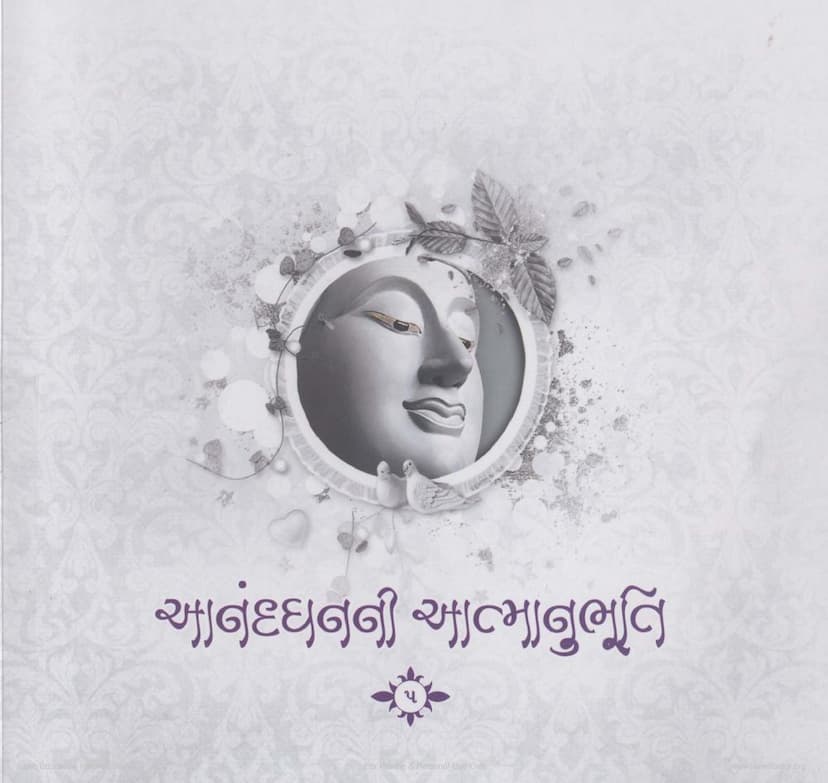Anandghan Ni Atmanubhuti 05
Added to library: September 1, 2025

Summary
This document is a commentary and explanation of the fifth spiritual verse (Pancham Pad) composed by the revered Jain mystic, Anandghanji Maharaj. The commentary is provided by Acharya Vijay Kalyanbodhisurishwarji Maharaj. The text is titled "Anandghan ni Atmanubhuti 05" and was published by Shri Jinshasan Aradhana Trust.
The core theme of this verse and its commentary revolves around the Jain philosophical principle of Syadvada, also known as the doctrine of conditional predication or the theory of "perhaps." Syadvada emphasizes that all truths are conditional and that a comprehensive understanding of any object or concept requires considering multiple perspectives.
Here's a breakdown of the key points discussed in the text:
1. The Essence of Syadvada and its Uniqueness:
- The text highlights Syadvada as a unique and profound philosophical principle that encapsulates the essence of reality.
- It contrasts Syadvada with other philosophical systems, suggesting that only Jainism, through the teachings of the Tirthankaras, truly grasped this principle. Other systems are presented as lacking this comprehensive understanding.
2. The Core Principle: Utpad, Vyaya, and Dhrauvya (Production, Decay, and Permanence):
- The commentary explains that every existing thing in the universe is characterized by production (utpad), decay (vyaya), and permanence (dhrauvya). This is illustrated with examples like milk turning into curd, where milk (goaras) is permanent, but the form changes (milk perishes, curd is produced).
- The concept is further elaborated through the analogy of a shirt, which undergoes continuous change (decay and production of states) at every moment, yet the substance (the shirt itself) remains identifiable. This illustrates that change and permanence coexist.
3. The "Anekanta" Principle (Non-one-sidedness):
- The text emphasizes the concept of Anekanta, the idea that reality is multifaceted and can be viewed from various standpoints. This is directly linked to Syadvada.
- The analogy of the blind men and the elephant is used to illustrate how partial perspectives lead to incomplete and often contradictory understandings. Each blind man perceives only a part of the elephant (leg, tail, ear) and describes it based on that limited experience, leading to conflict.
- The commentary stresses that true knowledge comes from integrating these multiple perspectives, much like a comprehensive understanding of the elephant encompasses all its parts.
4. The Seven-Fold Predication (Saptabhangi):
- A significant portion of the text is dedicated to explaining the Saptabhangi, the seven-fold syllogistic method of Syadvada.
- Syadasti (Perhaps it is)
- Syannasti (Perhaps it is not)
- Syadastinasti (Perhaps it is and it is not)
- Syadavaktavyah (Perhaps it is indescribable)
- Syadastiavaktavyah (Perhaps it is and it is indescribable)
- Syannastiavaktavyah (Perhaps it is not and it is indescribable)
- Syadastinastiavaktavyah (Perhaps it is, it is not, and it is indescribable)
- These seven modes are presented as a way to describe any object or concept without resorting to absolute or exclusive assertions, acknowledging the conditional nature of reality. The example of a glass being half-full and half-empty is used to illustrate this.
5. The Nature of the Soul and Reality:
- The text delves into the nature of the soul (Atman) and other substances, stating that they are both permanent (as a substance) and impermanent (in their modifications or states).
- It argues against extreme views:
- Eternalism (Anikant Nitya): The view that the soul is absolutely permanent and unchanging is criticized for denying the reality of change, experience of happiness/sorrow, and ethical actions like non-violence.
- Momentariness (Kshanika): The view that everything is momentary (like in some Buddhist philosophies) is critiqued for failing to explain continuity, memory, and causality (karma). The example of Gautam Buddha referring to past life karma is used to point out the implicit acceptance of a continuing self.
- Syadvada, by encompassing both permanence and change, provides a balanced and complete view.
6. The Impact of Syadvada on Spiritual Growth:
- The commentary emphasizes that understanding and internalizing Syadvada leads to equanimity (samata) and inner peace (samadhi).
- It helps in detaching from worldly desires and aversions, as one recognizes the conditional nature of all experiences.
- The principle fosters non-attachment (agrahmukti), which is seen as the path to freedom from negative emotions (kashayas) and ultimately, liberation (moksha).
- The text uses the metaphor of "nectar" (Sudha or Amrit) to describe the profound and immortalizing nature of the divine word (Jinvachanamrut), which is accessible through the understanding of Syadvada.
7. The "One is All, All is One" Concept:
- The commentary further explores the idea that "the one is all, and all is one." This means that realizing the true nature of one thing implies understanding the interconnectedness and underlying unity of all things.
- The example of gold (one substance) being made into various ornaments (many forms) and then melted back into gold illustrates the relationship between substance and form, unity and multiplicity.
- This understanding helps in cultivating a sense of universalism and seeing oneself in all beings and all beings in oneself.
In summary, "Anandghan ni Atmanubhuti 05" is a profound exposition of Syadvada, explaining its fundamental principles (Utpad, Vyaya, Dhrauvya, Anekanta, Saptabhangi) and their implications for understanding reality and achieving spiritual liberation. It advocates for a balanced, non-exclusive approach to knowledge, emphasizing that true wisdom lies in embracing multiple perspectives and thereby fostering equanimity, detachment, and ultimately, self-realization.